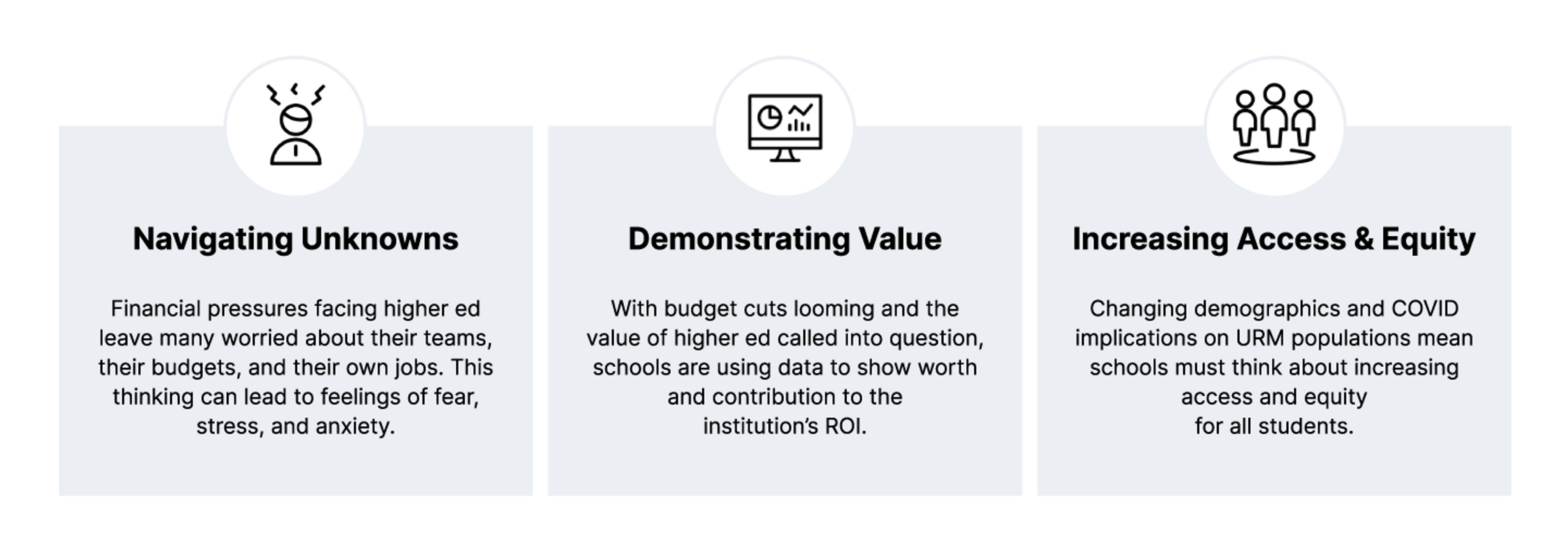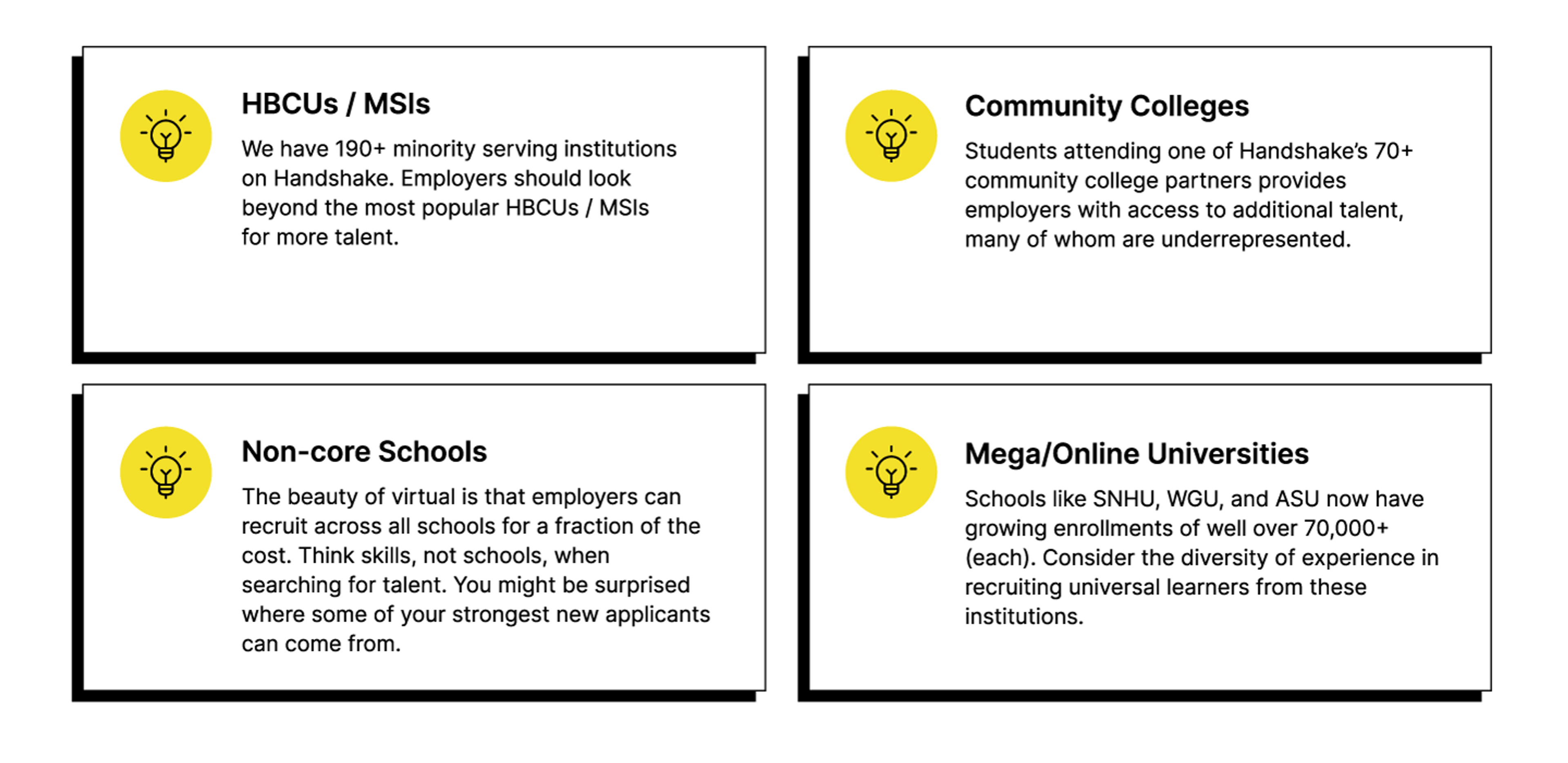The pandemic has impacted daily life in a multitude of ways, but its effect on higher education, which stands to lose approximately $183 billion, has been devastating. Faced with increasing financial pressure, colleges and universities around the country have been besieged by worries about their budgets, their teams, and their own jobs.
With the ROI of higher education being called into question, schools are being tasked more than ever with using data to demonstrate worth. Along with every department, career centers need to show exactly how they are contributing to the value of the institutions they serve. Meanwhile, The Centers for Disease Control (CDC) has shared evidence that some racial and ethnic minority groups have been disproportionately affected by COVID-19. The stark reality of inequity only compounds higher ed’s challenges.

Minority serving institutions (MSIs) such as historically black colleges and universities (HBCUs) and women’s colleges are already feeling squeezed, with families in even more need of financial aid than ever before. President Biden’s latest discretionary request to Congress includes nearly $40 billion for higher ed—an increase of more than $600 million to fund programs at HBCUs and MSIs.
There is so much more that employers can do beyond simply checking off the box on their MSI partnerships. Handshake is in a unique position to surface network trends, knowledge, and resources to further secure our partners. This includes raising awareness about ways employers can drive impact to their recruiting funnels by prioritizing underserved communities and about opportunities for employers to sponsor higher ed’s initiatives beyond the pandemic.
In this blog post, we share how employers can help their partners in higher ed by ‘leaning in’ and taking additional steps to help students. The more students who leave schools with job offers in hand, the more career centers can prove that they are an integral part of bridging the gap between college and career.
Cast a wide recruiting net
Rather than simply recruiting at the same few colleges over and over, employers can broaden their efforts to be more inclusive of schools they might have previously overlooked.
Handshake Premium partner Kiewit, a construction firm headquartered in Omaha, Nebraska, calls this “widening the pond,” and has intentionally sought out a diverse pool of candidates from four-year public institutions, historically black colleges and universities (HBCUs), hispanic-serving institutions (HSIs), women’s colleges, and more.
With women making up only 10% of those employed in construction, Kiewit has undertaken a multi-year, company-wide effort to increase its pipeline of female candidates—a notoriously difficult task in a male-dominated industry like construction. The odds didn’t stop them, and as a result of Kiewit’s strategic shift, the company has enjoyed impressive results: a 264% increase in women applicants since 2016.
A smarter way to approach early talent is to shift the focus away from individual schools to a broad set of skills. Handshake’s platform makes this easy; recruiters can search and filter only for software engineers with experience using Python or Java, for example, or students majoring in urban planning.
Handshake’s employer partners find that some of their strongest applicants come from unexpected places. This is just one of the reasons Handshake allows employers to recruit from thousands of schools—including 180 MSIs—for a fraction of the cost. The platform also offers access to 70+ community college partners who are a strong source of underrepresented populations.

Take a close look at what's working
It doesn’t make sense to continue recruiting ‘blind’ and spending valuable time and money on activities that don’t bring in qualified candidates. On Handshake, Premium employers are able to visualize exactly what percentage of applicants are coming from specific schools, understand their demographics, and gain a better understanding of where to double down.
With a company-wide effort to increase the diversity of its pipeline, Kiewit was able to see the breakdown—school by school—of its candidates. It was this type of data analysis that led them to discover a West Coast school with a strong engineering program. They subsequently pulled back efforts in less fruitful areas and increased their level of engagement both on and off campus.
Make campus connections
In addition to widening their school reach, employers can dive deeper into their partnerships to discover strong sources of untapped talent. Employers have found success by reaching out to career services at select schools of interest, introducing themselves; asking about sponsorship opportunities; and creating opportunities to conduct mock interviews or resume feedback sessions, for example.
In addition to career services, consider partnerships with student organizations like the National Society of Black Engineers (NSBE), the Society of Hispanic Professional Engineers (SHPE), or the Society of Women Engineers (SWE). Many of Handshake’s partners have made great inroads this way, cementing their brand’s impression on prospective hires.
Engage students with personalized outreach
Hosting in-person career fairs may eventually become a part of the normal suite of localized recruiting activities. But until then, employers should embrace digital in their outreach efforts to prospects—especially when tapping into talent nationwide—with one caveat.
Today’s students are wary of marketing—especially if it isn’t relevant or tailored to them. Personalizing an outbound message to a candidate can go a long way; it’s the difference between treating them like a number and treating them like a human being. Use the student’s name in your message and include reasons why you think he or she would be interested in your company—such as a declared major, interests, or skills. “Based on your skills and interests, we think you’d be a great fit for a role at Company X.” Invite them to attend virtual career fairs or to apply for specific roles within your company.
Employer Tip: With custom variables like first name, school, and major, Handshake Premium partners can personalize their outreach to target segments at scale.
Continue your culture of mentorship
When recruiting underrepresented populations, employers need to think long-term. It’s not just a matter of getting new hires in the door; you need to develop strategies for keeping them at your company. A mentorship program—like the peer mentor program offered by Kiewit—can have a positive impact on employee retention simply by offering friendship and support from coworkers who aren’t in a direct supervisory role.
We’re trying to make you feel comfortable and also see that you have other people that you can aspire to lean on who would have gone through similar experiences.
Erin Hadke, Senior Acquisition Talent Lead at Kiewit
In addition to mentor programs, the company also has regional Women in Kiewit groups that provide local support, discussions, and events.
“We're trying to make you feel comfortable and also see that you have other people that you can aspire to lean on who would have gone through similar experiences.”
Erin Hadke, Senior Acquisition Talent Lead at Kiewit
To learn more about Handshake Premium partner, Kiewit, and borrow a page from their early talent recruiting playbook, access the employer’s university relations guide.
Closing thoughts
The past year has brought so much turbulence and uncertainty to our nation’s college students, and we are eager to move forward with implementing change.
We’re encouraged by widespread efforts by employers to connect with MSIs, though the road to equity is still a long one. Now that campuses are preparing to reopen, employers can augment the success they’ve had digitally in the past year with in-person activities, ensuring that they instill smarter, data-backed programs as the foundation to their school strategy.
Person by person, institution by institution, program by program, we can all lend a helping hand.
